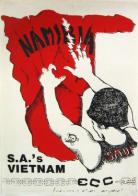On the 10th of December 2009, SAHA recounts the human rights struggles of the Namibian people on their road to freedom as they celebrate their own Human Rights Day. In this teenage democracy, human rights are enshrined in a Constitution. But the ancient scars of a painful history have neither been forgotten nor absolved. There is perhaps no other nation for which the United Nations' International Human Rights Day is more redolent than Namibia.
The genocide of the Herero
The point of departure for understanding human rights violations in Namibian history (previously known as South West Africa) is undoubtedly the arrival of imperial German forces in 1884. Within two decades, the German occupation had perpetuated the ethnic cleansing of at least 60 000 of the 80 000 members of the indigenous Herero tribe. Resistance from the Herero was brutally repressed, especially after General Lothar von Trotha called for their destruction in a declaration at Osombo-Windimbe in 1904. Herero prisoners of war were perhaps the earliest victims of eugenics. The later use of Jews, gypsies and homosexuals in similar pseudo-scientific experiments during the Second World War is perhaps better known - but it was during the Herero War that the use of human subjects for genetic testing was popularised.
The changing face of imperialism
"This apartheid that you are coming here to impose, you are trying to impose on a place that does not belong to you. Do you not know that this place belongs to us and to us alone?" - N. Mbaeva
The Germans continued to develop their colonial infrastructure until their defeat by the British and South African forces in 1915. After the First World War, South West Africa became a South African mandate. After 1948, social inequalities were entrenched through the extension of Verwoerd's notorious policy of ‘separate development'.
By 1959, the city of Windhoek had become the location for fierce oppression and resistance. Residents were dead-set against forced removals, and organised a municipal boycott on the 8th of December. Two days later, a peaceful demonstration gathered outside the South African administrative offices was attacked by security police, killing at least twenty five protesters.
It is this cataclysmic event that is commemorated on this day every year.
By 1962 the South West Africa People's Organisation (SWAPO) had emerged as a powerful force against the occupation. The Border War began in 1966 when the South African Defence Force engaged in cross-fire with SWAPO. By the early 1970s, SWAPO was recognised by the United Nations General Assembly as the sole representative of the Namibian people. In 1984, the first campaign of the newly forged End Conscription Campaign (ECC) in South Africa included a ‘Focus on Namibia'. Human rights lawyer Anton Lubowski, one of the first white Namibians to openly support SWAPO, campaigned throughout South Africa for Namibian independence.
By 1989, thirty years after the massacre at Windhoek, and just over a century since the first German colonial invasion, the independence of Namibia was negotiated. Tragically, just before SWAPO leader Sam Nujoma was due back after almost thirty years in exile, Lubowski was assassinated on the 12th of September.
This shocked Namibian society, but it could not derail the democratisation process, which was finally secured when the new Constitution came into force in 1990.







